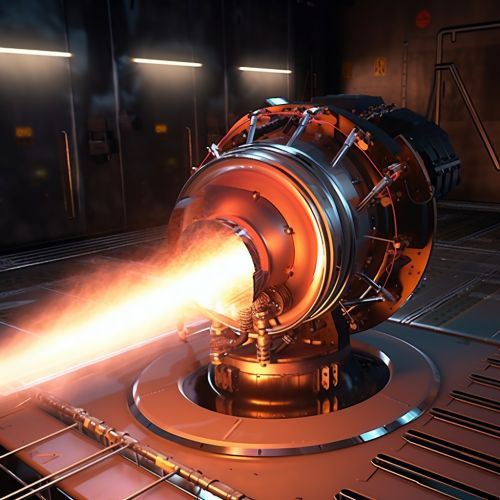Hall effect thruster
Introduction
The Hall effect thruster (HET) is a type of ion thruster, a device that accelerates ions to generate thrust in spacecraft propulsion. Named after Edwin Hall, who discovered the Hall effect, this thruster is distinguished by its use of an electric field to ionize a propellant gas, and a magnetic field to accelerate the resulting ions.
Principle of Operation
The Hall effect thruster operates on the principle of plasma acceleration. A propellant gas, typically xenon or krypton, is injected into the thruster's chamber. An electric field, created by a voltage difference between the anode and the cathode, ionizes the propellant. The resulting ions are then accelerated by a magnetic field, which is orthogonal to the electric field, towards the exit of the thruster, generating thrust.


Design and Construction
Hall effect thrusters are typically cylindrical in shape, with the anode at one end and the cathode at the other. The anode is usually a hollow cylinder, through which the propellant gas is injected. The cathode, on the other hand, is a rod-like structure, placed at the center of the anode. A magnetic field is created by a set of coils, which are wrapped around the thruster's body.
Performance and Efficiency
Hall effect thrusters are known for their high efficiency and long operational life. They are capable of achieving specific impulses (a measure of propellant efficiency) in the range of 1,500 to 2,000 seconds, which is significantly higher than that of chemical rockets. Moreover, their operational life can extend up to tens of thousands of hours, making them suitable for long-duration space missions.
Applications
Hall effect thrusters have been used in a variety of space missions, including satellite station-keeping, orbit raising, and deep space exploration. They have been employed in both governmental and commercial spacecraft, such as communication satellites and interplanetary probes.
Advantages and Disadvantages
The main advantage of Hall effect thrusters is their high efficiency, which allows for significant fuel savings. However, they also have some disadvantages. For instance, they require a power source to generate the electric and magnetic fields, which can add complexity and weight to the spacecraft. Additionally, the ionized gas can cause erosion of the thruster's components, reducing its operational life.
Future Developments
Research is ongoing to improve the performance and lifespan of Hall effect thrusters. This includes the development of new materials for the thruster's components, as well as the optimization of the thruster's design and operation.
